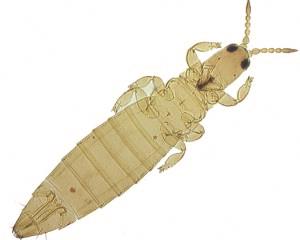Insect Gallery
Insect Details
Thrips
The western flower thrips and the tobacco thrips are two very destructive species. Adult thrips are usually less than 1/16 inch in length. The adult western flower thrip is yellow or yellow-orange; the tobacco thrip adult tends to be dark brown to black in appearance. Adult thrips have two pair of fringed wings. Larvae are very small at about 1/100 inch in length. They are white or cream-colored during the first instar, turning more straw-colored during later stages. There is a pupal stage that occurs in the soil.
Thrips have a unique life cycle. The adult lays her eggs in plant tissue. The larvae hatch and enter two (maybe more) instars before entering the pre-pupal and pupal stage in the soil. The pupae emerge as winged adults and migrate back to the plants or out of the field. The entire cycle from egg to adult requires from 12 to 16 days.
Thrips cause noticeable damage to seedling stage plants. They rasp the leaves and terminal buds with their sharp mouthparts and feed on the escaping juices. Leaves may turn brown on the edges, develop a silvery color, and may become distorted and curl or cup upward. Early, moderate to severe thrips injury can delay maturity. They cause various types of mechanical injury to the fruiting structures. These include pits, buckskin, black specks, raised blisters and cat-facing. This is the more significant damage caused by thrips.
